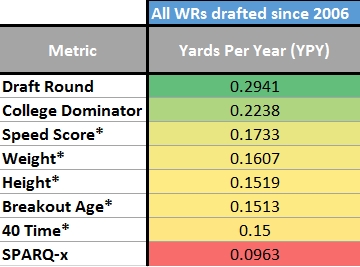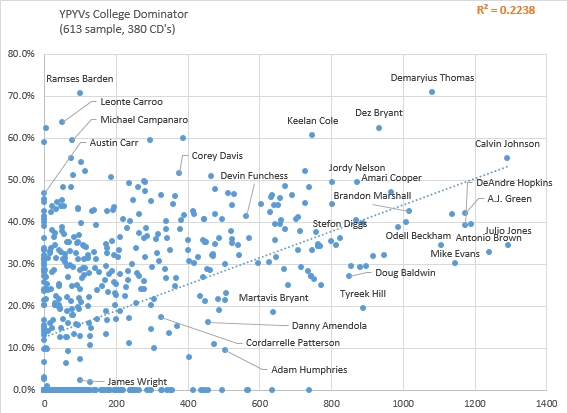Adhering to the annual offseason schedule, most dynasty leaguers are busy assessing the incoming rookie class. We don’t have combine numbers, draft capital, landing spots, or reliable measurement data yet. However, on each and every player page at PlayerProfiler.com, we already have access to one significant advanced metric: College Dominator Rating. It measures a player’s percentage of receiving yards and touchdowns in college. How much can it tell us? Here are some rookie wide receivers from the 2018 draft class with particularly interesting advanced stats and metrics player profiles.
Context
For context, I compared the same sample against draft round. Not everyone is enamored by the coefficient of determination (the correlation coefficients in orange on my graphs), thus some additional context may be in order for how useful College Dominator Ratings are in player assessments. Of the 55 players who have had 1,000-yard receiving seasons since 2006, 40 (nearly 73-percent) were drafted within the first three rounds of the NFL Draft. This high connection is what enamors many with draft capital. Correlation refers to whether two variables are connected or not. The higher the decimal point on the table below is, the stronger the correlation between yards per year and the respective metric is. Draft capital has a correlation coefficient of 0.29 with yards per year, whereas College Dominator comes in at 0.22. Both of those metrics boast a strong correlation with yards per year
Athletic statistics such as 40-yard dash time, Agility Score, and composite scores like SPARQ-x Score, are almost entirely unrelated to NFL success by themselves.
Table: R-squared Values for metrics against YPY since 2006 (* = only players with scores)
College Dominator Rating is the only metric that comes close to draft capital by itself. Of course, no single data point should be used to evaluate a prospect. To wit, Antonio Brown, a former sixth-round draft pick, currently represents the ceiling for wide receivers. Draft capital is a measurement of a team’s investment in a player and is a strong indicator of a player’s likely opportunity. Opportunity is a very important component of a player’s success. College Dominator Rating is a way of identifying players that have the potential to take advantage of their opportunities. In that way, it provides a window into how a player will seize their repetitions at the professional level.
Repeatable Yardage
No player has recorded multiple 1,000-plus yard seasons with a College Dominator Rating less than 25-percent besides Julian Edleman, who played quarterback in college. To provide some context for how well it can define the limits of a player’s upside, I divided the total number of yards by the total number of years for every player since 2006. Yards per year is not a perfect way of measuring players. It’s hard to judge first and second-year players against someone like Brandon Marshall with a straight face. Marshall only had 309 yards in his first year, before amassing eight 1,000-yard seasons. Corey Davis had 375 yards in 2017. YPY gives us some measure for how these players have performed to this point for fantasy.
Getting over 800 YPY with a College Dominator Rating less than 30-percent is rare. In the past seven years, only two players (Tyreek Hill (888 YPY) and Kelvin Benjamin (880 YPY)) have accomplished that feat. If we go back twelve years, only three others emerge: Doug Baldwin (2012), Mike Wallace (2009), and Jeremy Maclin (2009). A player consistently posting multiple fantasy relevant receiving seasons with a College Dominator less than 30-percent is highly unlikely. It’s not the type of player we are going to find in every draft class or even every other draft class. Hill stands out even in this group as a remarkable outlier. He is now the only player with a College Dominator less than 20-percent, and it’s hard to compare his two-year stretch to Doug Baldwin and his 27-percent College Dominator Rating. Baldwin’s 849 YPY over seven years includes three uneventful seasons prior to his fourth-year breakout.
Relationship to Breakout Age
Kelvin Benjamin is the only player averaging over 800 YPY with less than a 30-percent College Dominator, and he broke out in his rookie year. Like YPY, NFL breakout year has a relationship to the College Dominator metric. In short, the lower the College Dominator Rating, the longer it takes to break out. Moreover, it will likely indicate the quality of that breakout if it happens.
In a 12-year sample of eight players (including Edelman) without high College Dominator Ratings who reached 800-plus yards in a season, only Anthony Armstrong did it in his first year. He also accumulated a measly 107 receiving yards over the rest of his career. Marquise Goodwin, Andrew Hawkins and Travis Benjamin all achieved 800-plus yard seasons with sub-25-percent College Dominators, but none of them did it in their rookie year, and none have repeated the performance. One year is nice, but it’s not nearly as valuable.
Most importantly, a higher College Dominator correlates to a better breakout. Jordy Nelson, Golden Tate, Emmanuel Sanders, Rishard Matthews and Pierre Garcon all broke out after year four. They were drafted in different rounds, mostly ranging from the second to the seventh. Interestingly, all of them have a College Dominator Rating greater than 34-percent. That’s something we can target even after a player’s first few years.
The Outlier
Tyreek Hill could put a small dent in the history of the metric. With only a 19.4-percent College Dominator Rating (21st-percentile), he gained 1,183 receiving yards last season and became the lead wide receiver for the Chiefs. He’s now flirting with a first-round ADP. While many are enjoying being “right,” those who value the correlation of college production to NFL success are left with a reminder that no one number is an iron-clad argument.
Tyreek Hill is the first wide receiver since Percy Harvin to post more than 800 yards receiving in a single season after posting a College Dominator Rating below 20-percent. Was 2017 a fluke? If Hill continues this impressive start to his NFL career, he will be a once-a-decade outlier at the wide receiver position.
The lesson isn’t that College Dominator Ratings don’t matter. The lesson is that sometimes there are unknowns in the background of a player and that should make us more cautious with their metrics. Tyreek Hill boasts one college season with 504 yards and a single touchdown. His college career was plagued by inconsistency and a one-dimensional role. Unlike the majority of consistent fantasy players at his position, he was unable to produce in college. Those who “got him right” took a risk, because we honestly didn’t know what he could do. We still don’t, as now he must continue learn and improve while playing in the NFL.
College Dominator Ratings can tell us a lot about players who actually played in college, but not much about those who didn’t.
The 2018 Class: A Short-List
Using PlayerProfiler.com’s Data Analysis Tool, it’s easy to create a list and then sort by College Dominator Rating. It’s fairly easy to then sort by a minimum 25- or 30-percent College Dominator Rating. This group represents the most likely to break out, which they are more likely to do in their rookie year. In addition, their higher rating also indicates their potential breakouts will be more valuable in fantasy.
Several players stand out as the most productive between the ages of 18-20 years old. This is another way of digging into college production and breaking down the unknowns inside it that has proven predictive. I’ve been working on collecting the market share production of all wide receiver with the help of a large data supply from @Slavin22. If you want to dig deeper into college production, you can find it here:
2018 Rookie WR Class: Market Share By Age data: https://t.co/wfqqvG7eHR
— Peter Howard (@pahowdy) February 3, 2018
Players that stand out and compare to successful wide receivers in the NFL include Christian Kirk, D.J.Moore, James Washington, Justin Watson and Jake Wieneke. There are also a few that could be overvalued based on the numbers behind their College Dominator Ratings.
Courtland Sutton
When asked about Courtland Sutton, the overall response seem’s to be a collective shrug. He’s been consistently productive for his team since he was 19 years old and has more than 30-percent of his team’s production in receptions, yards and touchdowns since he was 20. While his production has been largely skewed towards touchdowns, he doesn’t exactly miss a mark, but he doesn’t wow anywhere.
The average production for the college career of the most consistent wide receivers in the NFL since 2006 is 27-percent of receptions, 27-percent of yards and 33-percent of touchdowns. Suttons’s averages are 19-percent, 25-percent, and 31-percent. Does he hit the mark? Just barely, but like his final season, it’s going to depend a lot on his landing spot.
Calvin Ridley
Calvin Ridley might get drafted in the first round, but whichever team rolls the dice on him is chasing an outlier. I am a proponent of outliers. I root for every undrafted free agent in the league, and I’m still waiting for Tanner Gentry to get back on an active roster. Having said that, the level of enthusiasm for Ridley given his complete lack of production before the age of 20 is baffling.
Is Calvin Ridley doomed by his lack of early production? Not necessarily. We don’t know why he didn’t start his college career until a later age, nor should we care. It’s hardly outside the realm of possibility that Ridley can succeed at the NFL level. The danger is letting luck with a guy like Tyreek Hill make you believe it’s the norm.
In fairness, other players have gone through a similar lack of production and performed well in the NFL. Brandon Marshall didn’t produce more than 17-percent of his college teams’ receiving yards until he broke out in his final year with 39-percent. Michael Thomas didn’t even average more than 7-percent of his teams receiving yards before he was 20. Both are examples of players who have succeeded despite a lack of early production. But both were also on the field and playing at 18, 19 and 20. Does that play a role? We don’t know. Is there a clear exception more like Ridley? A.J Green didn’t play until he was 20 either. In Green’s first college season at age 20, he netted 20-percent of Georgia’s receptions, yards, and touchdowns. Is one example enough? Is Ridley like A.J Green in any other way? No and no.
Conclusion
College Dominator Rating is the perfect starting point when evaluating rookie wide receiver prospects. However, Leontee Carroo is not necessarily more valuable as a stash candidate than Carlos Henderson. Yet, both players appear to be guys who can succeed with an opportunity over Kevin White, Mike Williams and Philip Dorsett once you break down the unknowns in their College Dominators.
Reading the situation and player is also important, which is why we need more data from the combine and NFL draft. Either way, we should continue to value the metric as their career progresses.
The longer a player remains in the NFL, the more likely his experience can make up for his lack of college production. As of now, there are no examples to suggest that a player with low college production can maintain a breakout. In the meantime, every successive fantasy relevant season increases the threshold of a player’s College Dominator Rating.





